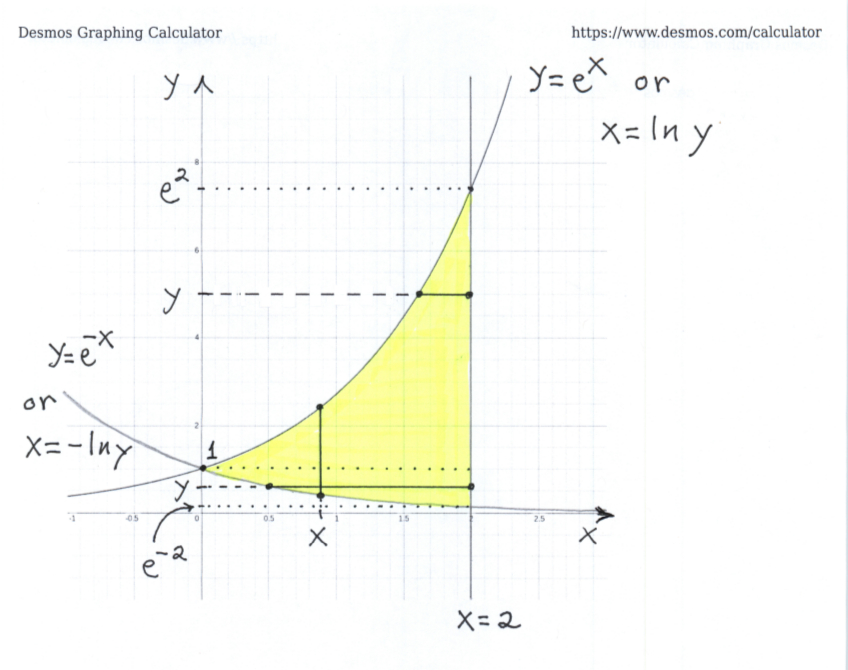SOLUTION 26: Compute the area of the region enclosed by the graphs of the equations $ y=e^x \ \ (or \ \ x=\ln y)$,
$ y=e^{-x} \ \ (or \ \ x=-\ln y) $, and $x=2$ . Begin by finding the points of intersection of the the three graphs.
From $ y=e^x $ and $ y=e^{-x} $ we get that
$$ e^x = e^{-x} \ \ \longrightarrow $$
$$ x = -x \ \ \longrightarrow $$
$$ 2x = 0 \ \ \longrightarrow \ \ x=0 \ \ (and \ y=1) $$
From $ y=e^x $ and $ x=2 $ we get that
$$ y = e^{2} $$
From $ y=e^{-x} $ and $ x=2 $ we get that
$$ y = e^{-2} $$
Now see the given graph of the enclosed region.

a.) Using vertical cross-sections to describe this region, we get that
$$ 0 \le x \le 2 \ \ and \ \ e^{-x} \le y \le e^x \ , $$
so that the area of this region is
$$ AREA = \displaystyle{ \int_{0}^{2} ( Top \ - \ Bottom ) \ dx } $$
$$ = \displaystyle{ \int_{0}^{2} ( e^x - e^{-x} ) \ dx } $$
$ \Big( $ Recall that $ \displaystyle{ \int e^{kx} \ dx } = \displaystyle{ \frac{1}{k} e^{kx} + C } $. $ \Big) $
$$ \displaystyle { = ( e^x - ( - e^{-x} )) \Big\vert_{0}^{2} } $$
$$ \displaystyle { = ( e^x + e^{-x} ) \Big\vert_{0}^{2} } $$
$$ \displaystyle { = ( e^{(2)} + e^{-(2)} ) - ( e^{(0)} + e^{-(0)} ) } $$
$$ \displaystyle { = e^{2} + e^{-2} - ( 1 + 1 ) } $$
$$ \displaystyle { = e^{2} + e^{-2} - 2 } $$
b.) Using horizontal cross-sections to describe this region, which is made up of two smaller regions, we get that
$$ e^{-2} \le y \le 1 \ \ and \ \ - \ln y \le x \le 2 \ , $$
in addition to
$$ 1 \le x \le e^2 \ \ and \ \ \ln y \le y \le 2 \ , $$
so that the area of this region is
$$ AREA = \displaystyle{ \int_{e^{-2}}^{1} ( Right \ - \ Left ) \ dy + \int_{1}^{e^2} ( Right \ - \ Left ) \ dy } $$
$$ = \displaystyle{ \int_{e^{-2}}^{1} ( 2 - (- \ln y) ) \ dy + \int_{1}^{e^2} ( 2 - \ln y ) \ dy } $$
$$ = \displaystyle{ \int_{e^{-2}}^{1} ( 2 + \ln y ) \ dy + \int_{1}^{e^2} ( 2 - \ln y ) \ dy } $$
$ \Big( $ Use Integration by Parts to integrate $ \ \displaystyle{ \int \ln y \ dy } $. Recall that the Integration by Parts formula is
$ \displaystyle{ \ \int u \ dv } = uv - \displaystyle{ \int v \ du } $. Let $ \ u = \ln y \ $ and $ \ dv = dy \ $, so that
$ \displaystyle{ \ du = \frac{1}{y} dy \ } $ and $ \ v=y \ $. Then
$$ \displaystyle{ \int \ln y \ dy = y \ln y - \int y \cdot \frac{1}{y} \ dy } $$
$$ \displaystyle{ = y \ln y - \int 1 \ dy } $$
$$ \displaystyle{ = y \ln y - y + C } \ \Big) $$
Continuing with the definite integral, we get that
$$ = \displaystyle{ \int_{e^{-2}}^{1} ( 2 + \ln y ) \ dy + \int_{1}^{e^2} ( 2 - \ln y ) \ dy } $$
$$ \displaystyle{ = ( 2y + (y \ln y - y) ) \Big\vert_{e^{-2}}^{1} + ( 2y - (y \ln y - y) ) \Big\vert_{1}^{e^{2}} } $$
$$ \displaystyle{ = ( y + y \ln y ) \Big\vert_{e^{-2}}^{1} + ( 3y - y \ln y ) \Big\vert_{1}^{e^{2}} } $$
$$ \displaystyle{ = \Big( \Big( (1) + (1) \ln (1) \Big) - \Big( (e^{-2}) + (e^{-2}) \ln (e^{-2}) \Big)
+ \Big( \Big( 3(e^2) - (e^2) \ln (e^2) \Big) - \Big( 3(1) - (1) \ln (1) \Big) \Big) } $$
$$ = (1+0) - (e^{-2} + e^{-2}(-2)) + (3e^2 - e^2(2) ) - (3-0) $$
$$ = e^{2} + e^{-2} - 2 $$
Click HERE to return to the list of problems.

